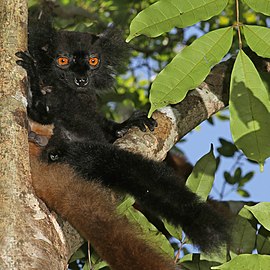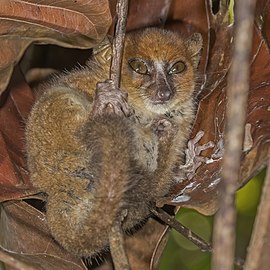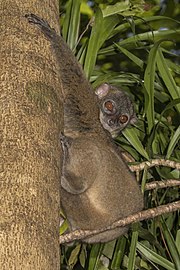
The Madagascar lowland forests or Madagascar humid forests are a tropical moist broadleaf forest ecoregion found on the eastern coast of the island of Madagascar, home to a plant and animal mix that is 80 to 90% endemic, with the forests of the eastern plain being a particularly important location of this endemism. They are included in the Global 200 list of outstanding ecoregions.

The Madagascar subhumid forests are a tropical moist broadleaf forest ecoregion that covers most of the Central Highlands of the island of Madagascar. They are included in the WWF's Global 200 list of outstanding ecoregions. Most of the original habitats have been lost due to human pressure.

The black lemur is a species of lemur from the family Lemuridae. Like all lemurs, it is endemic to Madagascar. Originally, the species was thought to have two subspecies, Eulemur macaco macaco and Eulemur macaco flavifrons, both of which were elevated to species status by Mittermeier et al. in 2008 to Eulemur macaco and Eulemur flavifrons respectively. The most startling difference between the two species is the eye colour; Eulemur flavifrons, the blue-eyed black lemur, has blue eyes, while Eulemur macaco, the black lemur, has brown or orange eyes, and also has ear tufts.

Masoala National Park, in northeast Madagascar, is the largest of the island's protected areas. Most of the park is situated in Sava Region and a part in Analanjirofo. Created in 1997, the park protects 2,300 square kilometres of rainforest and 100 square kilometres of marine parks. The Masoala peninsula is exceptionally diverse due to its large size, and variety of habitats. Altogether, the park protects tropical rainforest, coastal forest, flooded forest, marsh, and mangrove. Three marine parks protect coral reefs and a dazzling array of marine life.
Nosy Mangabe is a small island reserve located in Antongil Bay about 2 km offshore from the town of Maroantsetra in north-east Madagascar. it is accessible by small boat and is part of the larger Masoala National Park complex. It is a tropical rainforest national park for a species of lemur, the aye-aye. It lies close enough to Maroantsetra for a day trip, although an overnight stay is recommended for seeing the nocturnal aye-aye.
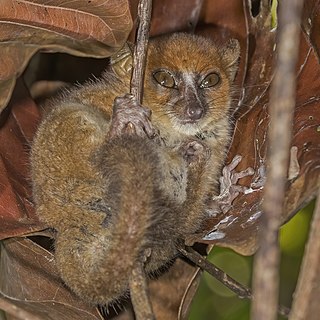
Claire's mouse lemur, or the Nosy Be mouse lemur, is a newly described species of lemur from the genus of the mouse lemurs (Microcebus). It lives on the island Nosy Bé in the Antsiranana province of Madagascar, and on the mainland near the village of Manehoka, including Lokobe Reserve. The scientific type name, mamiratra, comes from Malagasy and means "clear and bright"; this refers the Theodore F. and Claire M. Hubbard Family Foundation, which has contributed to genetic research on Madagascar. This species is closely related to another new species, "M. species nova # 5"; which is related to the Sambirano mouse lemur, Microcebus sambiranensis, and the northern rufous mouse lemur, Microcebus tavaratra.

This list of national parks of Madagascar includes all officially recognized protected areas as of 2015. The protected areas network of Madagascar is managed by the Madagascar National Parks Association (PNM-ANGAP). The network includes three types of protected areas: Strict Nature Reserves, National Parks and Wildlife Reserves. At the 2003 IUCN World Parks Congress in Durban, the Malagasy President, Marc Ravalomanana, announced an initiative to more than triple the area under protection from approximately 4,200,791 acres (17,000.00 km2) to over 14,826,322 acres (60,000.00 km2). This "Durban Vision", as it has been dubbed, involved broadening the definition of protected areas in the country and legislation has been passed to allow the creation of four new categories of protected area: Natural Parks, Natural Monuments, Protected Landscapes, and Natural Resource Reserves. As well as allowing these new objectives for protected areas management, the new legislation also provided for entities other than PNM-ANGAP to manage protected areas, such as government ministries, community associations, NGOs and other civil society organizations, and the private sector.
Articles related to Madagascar include:
Andasibe-Mantadia National Park is a 155 square kilometre protected area, located about 150 km east of Antananarivo, consisting principally of primary growth forest in Alaotra-Mangoro Region in eastern Madagascar. The park's elevation ranges from 800 to 1260 meters, with a humid climate. Average annual precipitation is 1700 mm, with rainfall on 210 days of each year. This rainforest is habitat to a vast species biodiversity, including many endemic rare species and endangered species, including 11 lemur species. The park's two component parts are Mantadia National Park and Analamazoatra Reserve, which is best known for its population of Madagascar's largest lemur, the indri.
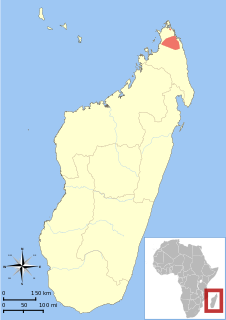
The northern rufous mouse lemur, northern brown mouse lemur, or Tavaratra mouse lemur is found in Northern Madagascar from the Ankarana National Park in the West to the river Manambato in Northeast and up to the Irodo river in the North of the Analamerana Special Reserve. The complete distribution range of M. tavaratra is still to be defined as some areas surrounding the described distribution have not been visited yet. For example, M.tavaratra has been reported to possibly occur from the Irodo up to the Montagne des Francais by Louis and collaborators in. Its known distribution cover four protected areas the Ankarana National Park, and the Analamerana Special Reserve both managed by Madagascar National Parks, the Loky-Manambato Region (Daraina) and the Andavakoeira-Andrafiamena protected area, both Managed by the NGO Fanamby
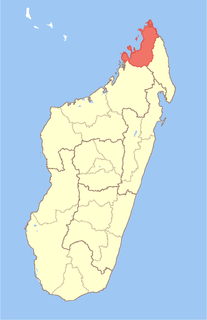
Diana is a region in Madagascar at the northeast part of the island. It borders the regions of Sava to the southeast and Sofia to the southwest. It covers an area of 19,266 km2, and had a population of 889,736 in 2018. The regional capital is Antsiranana.
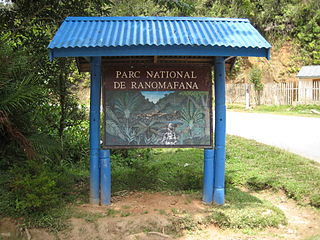
Ranomafana National Park is in the southeastern part of Madagascar in Haute Matsiatra and Vatovavy.

Analanjirofo is a region in northeastern Madagascar. Until 2009 it was a part of Toamasina Province. It borders Sava Region to the north, Sofia Region to the west, Alaotra-Mangoro Region to the southwest and Atsinanana Region to the south.

Tsimanampetsotsa National Park also spelt Tsimanampetsotse, and known as Tsimanampetsotsa Nature Reserve is a 432 km2 national park on the south-west coast of Madagascar in the region Atsimo-Andrefana. The park is 90 kilometres (56 mi) south of Toliara and 950 kilometres (590 mi) south of the capital, Antananarivo. Route Nationales (RN) 10 to Faux Cap passes the park and the nearest airport is at Toliara. The national park contains and is named after Lake Tsimanampetsotsa.
Maningoza Special Reserve is a 9,826 hectares wildlife reserve in Madagascar. It was created in 1956 to protect the many endemic plants and animals, and it also contains some of the last remaining areas of dry deciduous forest on the island.
Manongarivo Reserve is a wildlife reserve in the North-West of Madagascar in the region of Diana.
Marotandrano Special Reserve is a wildlife reserve in Mandritsara, Mahajanga, Madagascar. It is 10 km from Marotandrano and 42 km from Mandritsara.
Pic d'Ivohibe Reserve is a wildlife reserve of Madagascar. It was created in 1964.

Nosy Hara or Nosy Hara National Park is an uninhabited limestone islet off the northwest coast of Madagascar. It is the habitat of Brookesia micra, the smallest known chameleon. Since 2007, Nosy Hara has been part of a Marine Protected Area.
Mananara Nord National Park is a national park near Mananara Nord in the Analanjirofo Region of Madagascar. The closest city is Toamasina.

